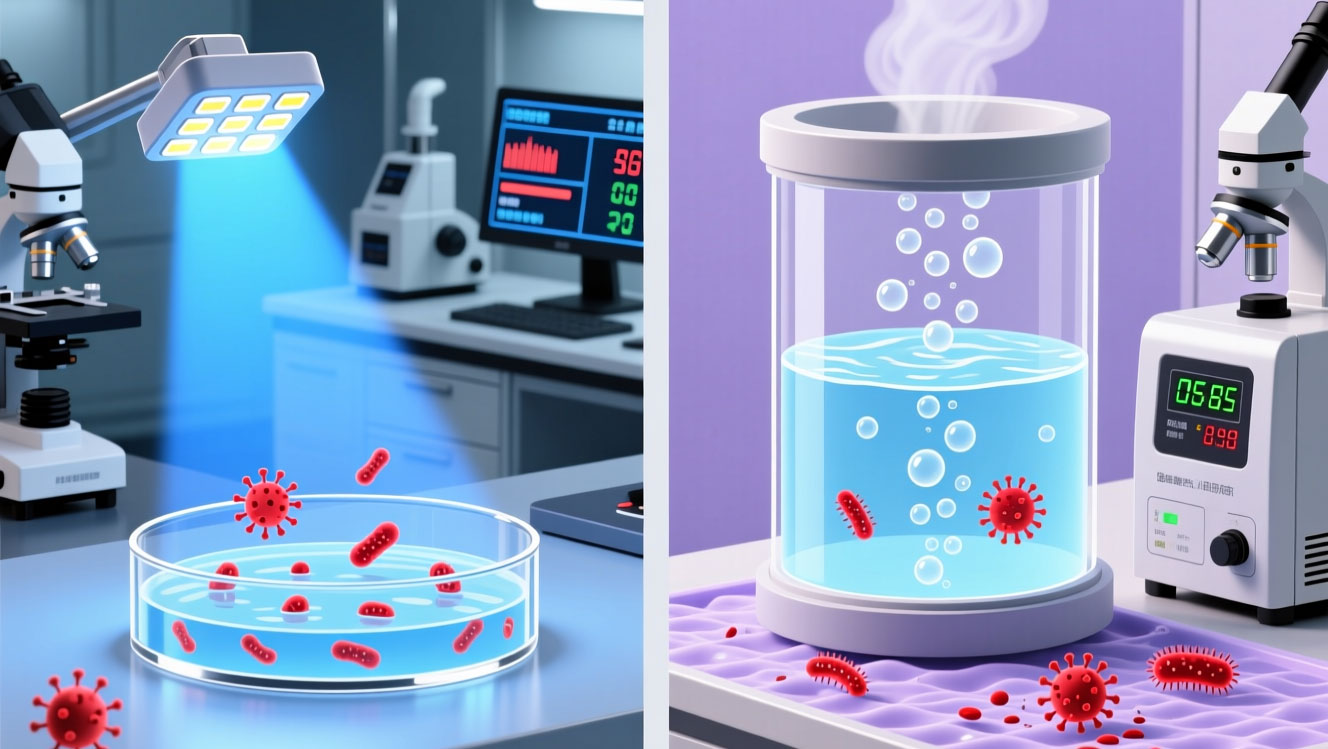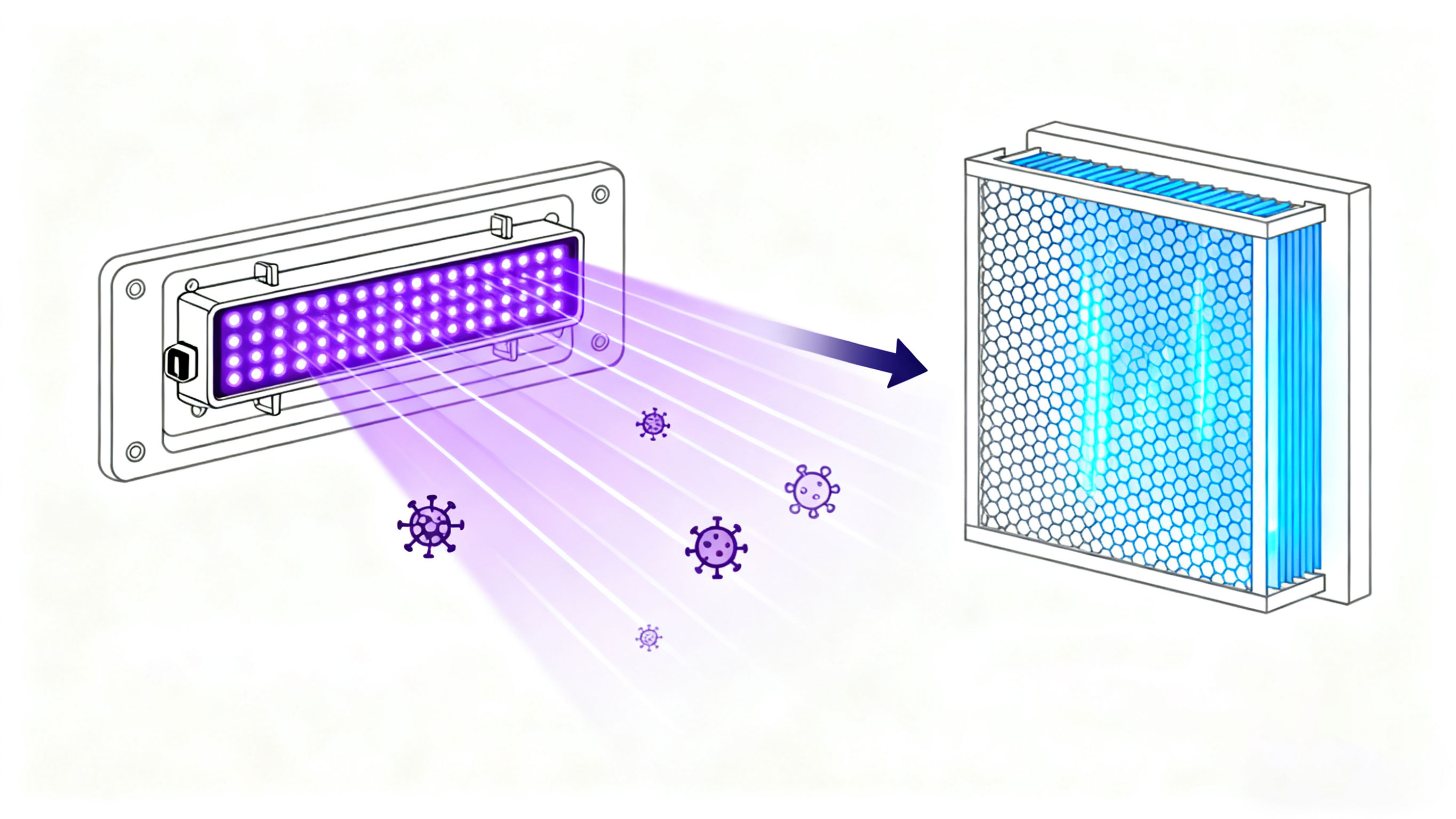Author: Site Editor Publish Time: 10-11-2025 Origin: Site











Airborne pathogens are a growing concern in today's crowded environments. From hospitals to offices, the need for clean air is more pressing than ever. UVC Air Disinfection offers a powerful solution, providing 99.99% sterilization without ozone production. In this article, we will explore the benefits and technology behind UVC air disinfection and its diverse applications.

UVC light is a type of ultraviolet radiation, with wavelengths ranging from 200 to 280 nanometers. It is a part of the electromagnetic spectrum, just beyond the visible light range, which is invisible to the human eye. Among the three types of UV light (UVA, UVB, and UVC), UVC light is the most germicidal, making it an ideal solution for disinfecting air and surfaces.
The germicidal properties of UVC light arise from its ability to disrupt the DNA or RNA of microorganisms. When pathogens such as bacteria, viruses, and fungi are exposed to UVC light, the energy from the UV photons is absorbed by their genetic material. This causes mutations, preventing the pathogens from replicating and rendering them harmless. This unique ability to prevent microorganisms from reproducing is what makes UVC light so effective as a disinfectant.
Unlike chemical disinfectants, which can leave harmful residues and require manual application, UVC technology provides continuous sterilization without the need for human intervention, making it a safe and sustainable air purification solution.
When it comes to air purification, traditional methods such as chemical fumigation and HEPA filtration have their uses, but each comes with limitations. Chemical fumigation involves using toxic substances that can pose a risk to both humans and the environment. These chemicals can leave residues that require additional cleaning, and they also need to be carefully handled and stored to avoid harmful exposure.
On the other hand, HEPA filtration is an effective method for trapping particles, but it doesn't actively eliminate the pathogens within the air. While HEPA filters can capture bacteria, dust, and other particles, they do not neutralize viruses or other microorganisms. In addition, HEPA filters can become clogged, reducing their effectiveness over time and requiring frequent maintenance and replacement.
UVC air disinfection stands out by providing a continuous, touchless, and chemical-free method of pathogen elimination. As the air circulates through the system, UVC light continuously disinfects the air by destroying the DNA or RNA of harmful pathogens. This approach not only reduces the risk of airborne diseases but also ensures that no secondary pollutants are released into the environment.
The effectiveness of UVC light in sterilizing air is attributed to its ability to target pathogens directly. The process begins when air passes through a UVC air disinfection system, which contains UVC lamps or LEDs emitting light at a specific wavelength, typically between 254-265 nm.
As the air travels through the system, the UVC light damages the genetic material of microorganisms, such as viruses, bacteria, and fungi. This damage disrupts the microorganisms' ability to replicate, effectively neutralizing them. Studies have shown that UVC light can reduce the viral load by 99.99% or more within minutes of exposure.
This process is especially effective for airborne pathogens, including those responsible for diseases like COVID-19, influenza, and tuberculosis. Additionally, UVC systems are effective against common allergens and molds that can contribute to respiratory problems and other health issues. The high sterilization rate ensures that UVC air disinfection systems are capable of significantly improving indoor air quality.
One of the primary concerns with traditional UV-C lamps is their potential to produce ozone. Ozone, a powerful oxidizing agent, can cause respiratory issues and other health problems if it accumulates in indoor spaces. However, UVC air disinfection systems have been designed to operate without producing harmful ozone.
Zero ozone production is one of the standout features of modern UVC systems. By using UV-C LEDs and specially engineered designs that focus on the germicidal wavelength of UVC light, these systems are able to provide effective air purification without the risks associated with ozone. This ensures that the air remains clean, fresh, and safe to breathe 24/7, making them ideal for environments like hospitals, schools, and homes where human health is a priority.
The primary benefit of UVC air disinfection systems is their ability to significantly improve indoor air quality by neutralizing airborne pathogens. Airborne diseases, bacteria, and allergens can circulate in the air, especially in crowded spaces or areas with inadequate ventilation. UVC systems actively destroy these harmful microorganisms, providing safer air for all occupants.
In healthcare settings, UVC systems help control the spread of nosocomial infections, which are infections acquired within medical facilities. These infections can be particularly dangerous to patients with weakened immune systems. In such environments, maintaining sterile air is critical, and UVC disinfection offers an efficient and non-intrusive solution.
In offices and schools, UVC air disinfection reduces the risk of airborne illnesses, contributing to the health and well-being of employees, students, and teachers. It is especially useful during flu seasons or global health crises, such as the COVID-19 pandemic, when airborne viruses can spread rapidly in communal spaces.
Modern UVC air disinfection systems are designed to be highly energy-efficient, ensuring that they provide maximum sterilization while consuming minimal power. Unlike traditional systems that rely on high-energy consumables like chemicals, UVC systems use LED lights that have an extended lifespan of up to 30,000 hours.
This low-maintenance technology requires very little upkeep beyond occasional cleaning or lamp replacements. With long-lasting UVC LEDs and simple designs, these systems reduce the overall operational costs, making them an excellent investment for businesses and institutions.
| Benefit | Traditional Methods | UVC Air Disinfection |
|---|---|---|
| Ozone Production | May produce harmful ozone | Zero Ozone |
| Energy Efficiency | Higher power consumption | Low Energy Consumption |
| Maintenance | High (due to chemical use) | Low Maintenance |
| Effectiveness | Limited to physical filtration | Continuous Pathogen Elimination |
In medical environments, the risk of cross-contamination is high, and maintaining a sterile air environment is crucial for patient safety. UVC systems are widely used in hospitals, nursing homes, and other healthcare facilities to ensure that the air is free from harmful pathogens. In patient rooms, operating theaters, and isolation wards, UVC systems help reduce the spread of infectious diseases, contributing to a cleaner and safer environment.
In commercial buildings, such as offices, hotels, and restaurants, UVC air disinfection systems help create a healthier atmosphere for customers and employees. These systems can be integrated into HVAC units to continuously disinfect the air without interfering with normal operations. They provide an added layer of protection against airborne viruses and allergens, improving overall air quality.
For residential applications, UVC systems can help those with respiratory conditions or allergies. In homes where family members may suffer from asthma, sinus issues, or other respiratory problems, UVC systems can provide relief by eliminating airborne pathogens and allergens.
In public spaces, including malls, fitness centers, and schools, the density of people increases the risk of disease transmission. UVC air disinfection plays a vital role in improving public health by continuously neutralizing airborne pathogens. In schools, UVC systems reduce the transmission of diseases, contributing to healthier learning environments. For fitness centers, where the air quality is particularly important, UVC systems help ensure the safety of both staff and customers.

One of the most effective ways to implement UVC air disinfection is by integrating the system into existing HVAC ducts. This ensures that all air circulating through the building is disinfected before it enters rooms or offices. The integration is seamless and allows for continuous air purification without the need for additional units or manual intervention.
UVC systems placed in the HVAC ducts continuously disinfect the air as it passes through, effectively neutralizing airborne pathogens and preventing the spread of diseases. This integration is especially useful in large buildings, such as hospitals and office complexes, where it’s important to maintain a clean air supply throughout the entire building.
In spaces where HVAC integration isn’t feasible, standalone UVC units are an ideal solution. These units are designed for specific rooms or areas that require localized disinfection. Whether in a patient’s room, a conference room, or a fitness studio, standalone units offer flexibility in installation and effective air purification in high-traffic areas.
UVC systems are designed with multiple safety features to protect users from exposure to harmful UVC radiation. These include auto shut-off mechanisms, which prevent UVC light exposure if the system is tampered with or opened, and overheat sensors to prevent overheating. Additionally, the UV shielding ensures that the germicidal UV light is contained within the system, reducing the risk of accidental exposure.
UVC air disinfection systems are highly adaptable, working efficiently in both high and low-temperature environments. Whether in a cold storage facility or a hot kitchen, these systems maintain optimal sterilization performance. The ability to operate in varied environmental conditions makes UVC air disinfection a reliable solution for diverse industries.
UVC air disinfection technology offers an effective solution for 99.99% sterilization without producing harmful ozone. It continuously disinfects the air, reducing airborne pathogens in healthcare, commercial, and residential settings. The system integrates seamlessly into various environments, ensuring cleaner, safer air. MASSPHOTON provides innovative UVC air disinfection solutions with low-maintenance and cost-effective features, ensuring healthier indoor air quality.
A: UVC Air Disinfection uses ultraviolet light to sterilize the air by neutralizing pathogens like viruses, bacteria, and fungi, offering 99.99% sterilization without producing harmful ozone.
A: UVC light targets the DNA or RNA of microorganisms, preventing replication and rendering them harmless, providing continuous air purification and pathogen elimination.
A: Unlike chemical fumigation or HEPA filtration, UVC Air Disinfection offers chemical-free, touchless sterilization, continuously disinfecting air without leaving residues.
A: Yes, UVC Air Disinfection systems are designed to operate safely 24/7, providing zero ozone exposure, making them suitable for environments with people, like hospitals or offices.
A: The cost of UVC Air Disinfection varies based on system size and features, but it is typically an energy-efficient and low-maintenance investment in the long term.